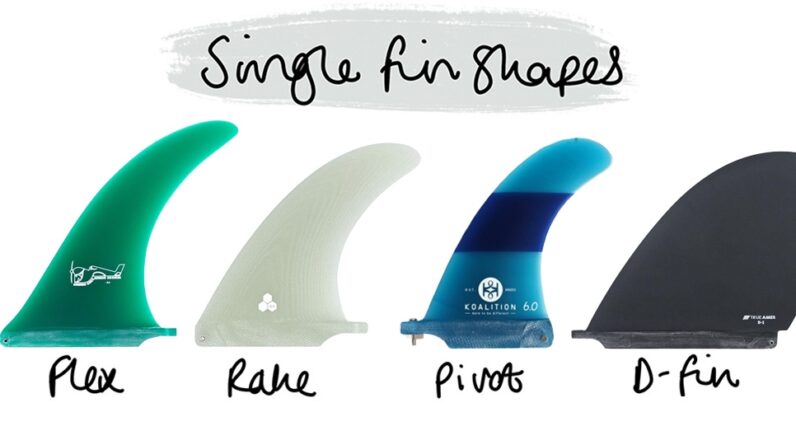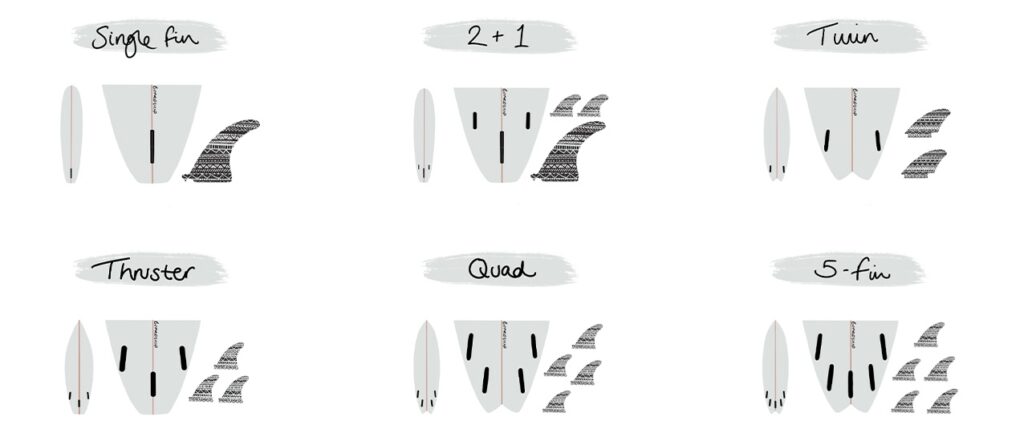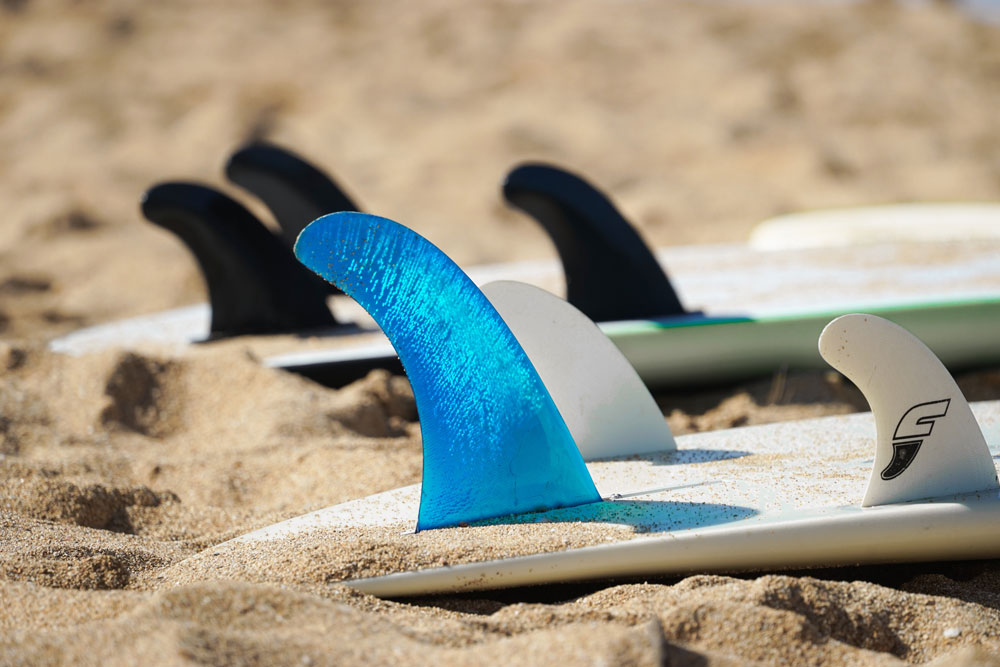
So you’ve decided to take up surfing – that’s awesome! But before you hit the waves, there’s an important decision you need to make: choosing the right surfboard fins. These nifty little accessories not only help you steer and control your board, but they also play a vital role in determining your stability and performance on the water. In this article, we’ll take you through the ins and outs of selecting the perfect surfboard fins for beginners, covering everything from size to style. By the end, you’ll feel confident and ready to ride those waves like a pro!
Understanding Surfboard Fins
Surfboard fins are an essential component of any surfboard. They are the small, fin-like structures typically found on the bottom of a surfboard, near the tail. These fins play a crucial role in a surfer’s ability to control their board and maneuver through the waves. Without fins, it would be nearly impossible to maintain stability and control while riding a surfboard.
Why are Surfboard Fins Important?
Surfboard fins are important for several reasons. Firstly, they provide stability, allowing surfers to maintain their balance on the board as they ride the waves. Fins also help the board track and maintain direction, preventing it from sliding out or skidding across the water. Additionally, fins provide control and maneuverability, enabling surfers to make quick turns and perform tricks with precision. Ultimately, the right surfboard fins can greatly enhance a surfer’s overall performance and experience in the water.

This image is property of assets.boardshop.co.uk.
Different Types of Surfboard Fins
There are various types of surfboard fins available, each designed to offer different performance characteristics. Here are some of the most common types:
Single Fins
Single fins, as the name suggests, consist of a single fin located in the center of the tail. These fins provide stability and control, making them suitable for longboards and retro-style surfboards. Single fins are known for their smooth and flowing ride, making them a popular choice for surfers who enjoy a more traditional and relaxed style of surfing.
Twin Fins
Twin fins, as the name implies, consist of two fins located near the tail of the surfboard. They offer a loose and playful feel, allowing for quick turns and increased maneuverability. Twin fins are often preferred for small-to-medium waves, as they provide greater speed and responsiveness.
Thruster Fins
Thruster fins, also known as tri-fin setups, are the most common type of surfboard fins. They consist of three fins: one larger center fin, commonly referred to as the “thruster fin,” and two smaller side fins. This setup offers a balance of stability, speed, and maneuverability, making it suitable for a wide range of surfers and wave conditions. Thruster fins are a versatile choice, providing enough control for beginners and enough performance for advanced surfers.
Quad Fins
Quad fins consist of four fins, with two larger fins near the front and two smaller fins near the back of the surfboard. This setup offers excellent speed, responsiveness, and maneuverability. Quad fins are particularly effective in generating speed in smaller waves and maintaining control in larger, more powerful waves. They offer a unique blend of speed and stability, making them a preferred choice for experienced surfers looking to push the limits of their performance.
5-Fin (Convertible) Fins
5-Fin or convertible fins provide the most versatility, as they allow surfers to switch between different fin setups. This setup typically includes both a thruster and quad fin option, allowing surfers to adjust their board’s performance based on the wave conditions and their preferences. 5-Fin setups provide the ultimate flexibility, enabling surfers to adapt to various wave conditions and experiment with different fin configurations.
Factors to Consider
When choosing the right surfboard fins, several factors should be considered to ensure the optimal surfing experience. These include the surfer’s skill level, the surfing conditions, and the type and setup of the surfboard.
Surfer’s Skill Level
A surfer’s skill level plays a significant role in determining the appropriate fin setup. Beginners often benefit from larger, more stable fins that provide enhanced stability and control. Intermediate surfers can experiment with various setups, depending on their preferences and the wave conditions. Advanced and professional surfers tend to opt for more dynamic and high-performance fins that offer greater maneuverability and responsiveness.
Surfing Conditions
The surfing conditions, such as wave size, shape, and power, also influence the choice of surfboard fins. For small, mushy waves, larger fins may be preferred to generate speed and maintain stability. In contrast, for larger, more powerful waves, smaller and more responsive fins may be necessary to provide control and maneuverability.
Board Type and Setup
The type and setup of the surfboard should also be taken into consideration when selecting fins. Longboards and retro-style boards often perform best with single fins, as they provide stability and a smooth, flowing ride. Shortboards and high-performance boards are typically designed for thruster or quad fin setups, as they offer greater maneuverability and responsiveness. It is essential to consult with a knowledgeable surf shop or shaper to determine the optimal fin setup for a specific board type.

This image is property of cdn.shopify.com.
Size and Shape
The size and shape of surfboard fins play a significant role in their performance characteristics. Here are the key factors to consider:
Foil
The foil refers to the shape or profile of the fin, specifically its thickness and curvature. Fins with a thicker foil offer more drive and stability, making them suitable for larger or slower waves. Fins with a thinner foil provide increased maneuverability and responsiveness, ideal for smaller or faster waves.
Base Length
The base length of a fin is the measurement from the front edge of the fin’s base to the back edge. Fins with a longer base length offer more stability and control, particularly in larger waves. Fins with a shorter base length provide quicker turns and increased maneuverability, making them suitable for smaller waves.
Depth
The depth of a fin refers to its measurement from the base to the tip. Fins with greater depth offer more stability, drive, and hold in larger waves. Fins with shallower depth provide looser and more responsive turns, better suited for smaller waves and high-performance surfing.
Sweep
The sweep, also known as rake, refers to the angle at which the fin’s leading edge curves backward. Fins with more sweep have a greater angle and provide increased hold and control, particularly in larger waves. Fins with less sweep offer quicker turns and increased maneuverability, making them ideal for smaller waves and dynamic surfing.
Trailing Edge
The trailing edge of a fin refers to the back edge of the fin. Fin design varies, with some fins having a straight trailing edge, while others have a curved or wavy shape. Fins with a straight trailing edge provide increased stability and hold, particularly in more powerful waves. Fins with a curved or wavy trailing edge offer increased maneuverability and responsiveness, making them suitable for smaller waves and high-performance surfing.
Construction Materials
The materials used in the construction of surfboard fins significantly affect their performance and durability. Here are the most common materials:
Plastic Fins
Plastic fins are typically the most affordable option and are commonly found in entry-level surfboards. While they may lack the performance characteristics of higher-end materials, plastic fins still provide adequate stability and control for beginners or casual surfers.
Fiberglass Fins
Fiberglass fins offer a good balance between affordability and performance. They have a consistent flex pattern and can be customized with different foils and shapes, allowing for more personalized performance.
Composite Fins
Composite fins are typically composed of layers of fiberglass and carbon fiber. They provide enhanced performance characteristics, such as increased responsiveness and speed. Composite fins are a popular choice among intermediate to advanced surfers looking for a lightweight and high-performance option.
Carbon Fiber Fins
Carbon fiber fins are the pinnacle of performance and often the choice of professional surfers. They are incredibly lightweight, provide maximum responsiveness, and offer exceptional speed and maneuverability. While carbon fiber fins may come with a higher price tag, their performance benefits make them worth considering for serious and competitive surfers.

This image is property of bgsbali.com.
Fin Systems
Fin systems refer to the mechanism by which the fins are attached to the surfboard. Different fin systems offer varying benefits and considerations. Here are some of the most common fin systems:
FCS (Fusion Control System)
FCS is one of the most popular fin systems, known for its versatility and ease of use. It features a two-tab system, allowing surfers to quickly and securely attach and remove fins without the need for tools. FCS fins come in a variety of sizes and styles, catering to different skill levels and wave conditions.
FCS II
FCS II is the next evolution of the FCS system, offering improved performance and simplicity. It features a tool-less fin installation system, allowing fins to be easily inserted and removed from the board. The FCS II system also provides a more secure fit, resulting in increased responsiveness and overall performance.
Future Fins
The Future Fins system utilizes a single, rear-facing tab that allows fins to slide and lock into place. This system offers a wide range of fin options, specifically designed to cater to various surfers and wave conditions. Future Fins are known for their durability and performance.
Glass-On Fins
Glass-on fins are not removable and are directly glassed onto the surfboard during the manufacturing process. This fin setup offers a more traditional and permanent option, providing excellent stability and control. Glass-on fins are commonly found on longboards and retro-style boards.
Removable Fin Systems
Removable fin systems, such as FCS and Future Fins, allow surfers to experiment with different fin setups and styles. These systems offer the flexibility of easily changing fins based on wave conditions, surfing preferences, or skill progression. Removable fin systems are a popular choice among surfers who seek versatility and the ability to fine-tune their performance.
Ride Characteristics
The choice of surfboard fins significantly impacts the ride characteristics of the board. Here are the key ride characteristics affected by the fins:
Speed
The right choice of fin setup can greatly impact a board’s speed. Fins that provide adequate drive and hold can generate greater speed, allowing surfers to glide across the waves with ease. The combination of fin size, shape, and construction material all contribute to the board’s speed potential.
Stability
Stability is crucial for maintaining balance and control on a surfboard. Fins that offer greater surface area and depth provide enhanced stability, enabling surfers to maintain their balance even in challenging wave conditions.
Maneuverability
Maneuverability refers to a surfer’s ability to make quick turns and navigate the waves with precision. Fins that provide increased responsiveness and allow for a greater range of motion contribute to improved maneuverability. Smaller fins with less sweep and depth tend to offer better maneuverability.
Control
Control is essential for surfers to direct their board and maintain their intended line in the wave. Fins that offer increased hold and traction, especially in more powerful waves, provide greater control. A balanced fin setup that offers a combination of stability and maneuverability usually provides optimal control.
Release
Release refers to the ability of a surfboard to release from the water when performing maneuvers and tricks. Fins that allow the tail of the board to break free more easily offer increased release, making it easier to perform critical turns and aerial maneuvers.

This image is property of assets.boardshop.co.uk.
Matching Fins to Skill Level
The choice of surfboard fins should align with the surfer’s skill level to ensure optimal performance and progression. Here are some general considerations for different skill levels:
Beginners
For beginners, stability and control are critical. Larger, more stable fins, such as thruster setups, provide the necessary balance and control for beginners to develop their skills. Fins with a greater surface area and depth offer enhanced stability, making them a suitable choice for beginners.
Intermediate Surfers
Intermediate surfers have typically developed a basic level of comfort and skill in the water. They can begin to experiment with different fin setups, depending on their preferences and the type of waves they frequently encounter. Intermediate surfers may opt for more responsive and high-performance fins to further enhance their maneuverability and overall surfing experience.
Advanced Surfers
Advanced surfers are typically seeking the ultimate performance and fine-tuning of their board. They tend to favor high-performance fins that offer maximum responsiveness, speed, and maneuverability. Advanced surfers often fine-tune their fin setups to match specific wave conditions or personal preferences.
Professional Surfers
Professional surfers have honed their skills to an elite level, pushing the boundaries of what is possible on a surfboard. They require the highest level of performance from their equipment, including their fins. Professional surfers often have custom-made or specialized fins designed to their exact specifications and preferences.
Choosing Fins for Different Conditions
Different surfboard fins perform better in specific wave conditions. Here are some recommendations for choosing fins based on the type of waves:
Small Waves
For small, mushy waves, fins with increased surface area and depth are desirable. This allows for better generation of speed and stability. Twin fin setups or larger thruster setups can be effective in small waves, providing a loose and responsive feel.
Medium Waves
Medium-sized waves offer a wider range of options for fins. Thruster setups are generally a safe choice, providing a balance of speed, stability, and maneuverability. Fins with medium-sized depth and sweep can help navigate smoothly through medium-sized waves.
Big Waves
In larger, more powerful waves, fins with increased hold, control, and responsiveness are necessary. Quad fin setups or larger thruster setups can provide the necessary stability and maneuverability to handle big waves. Fins with greater depth and sweep offer better hold and control in powerful waves.
Hollow Waves
In hollow waves with steep faces and powerful barrels, fins that offer maximum control and hold are crucial. Thruster setups are often preferred, as they provide the needed stability and responsiveness. Fins with a greater sweep and depth provide increased hold, allowing surfers to maintain control while navigating through the barrel.
Glidey Waves
Glidey waves, characterized by their long and mellow nature, require fins that offer stability and the ability to generate speed. Longer fins, such as those found in single fin setups or alternative fin configurations, can provide the necessary glide and flow for these waves. Fins with increased base length and surface area help generate speed.

This image is property of bgsbali.com.
Experimenting and Fine-Tuning
Surfers are encouraged to experiment and fine-tune their fin setups to optimize their performance and enjoyment in the water. Here are some recommendations for experimenting with fins:
Trying Different Fins
Surfers can try different types and setups of fins to see how they impact their surfing experience. Renting or borrowing different fins from friends or surf shops can provide valuable insights into how different fins perform in various waves. It’s important to keep notes on each fin setup to track personal preferences and performance characteristics.
Adjusting Fin Setup
Small adjustments to the fin setup can make a significant difference in a board’s performance. Surf shops or shapers can provide guidance on making adjustments to fin positioning or swapping out fins of different sizes. These adjustments can enhance specific ride characteristics such as speed, maneuverability, or stability.
Seeking Professional Advice
For surfers who are serious about their performance or seeking guidance, consulting with a knowledgeable surf shop or experienced shaper can provide valuable insights and recommendations. These professionals can assess a surfer’s skill level, riding style, and preferred wave conditions to suggest the most suitable fins and setups.
In conclusion, choosing the right surfboard fins is crucial for optimizing a surfer’s performance and enjoyment in the water. It involves considering factors such as the surfer’s skill level, the wave conditions, the type and setup of the surfboard, and the characteristics of the fins themselves. By understanding the different types of fins, their size and shape characteristics, the construction materials used, the various fin systems available, and how each of these factors affects ride characteristics, surfers can make informed decisions when selecting their fins. Experimenting, fine-tuning, and seeking professional advice all contribute to finding the perfect surfboard fin setup, allowing surfers to ride the waves with confidence, control, and style.






